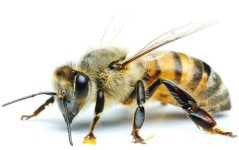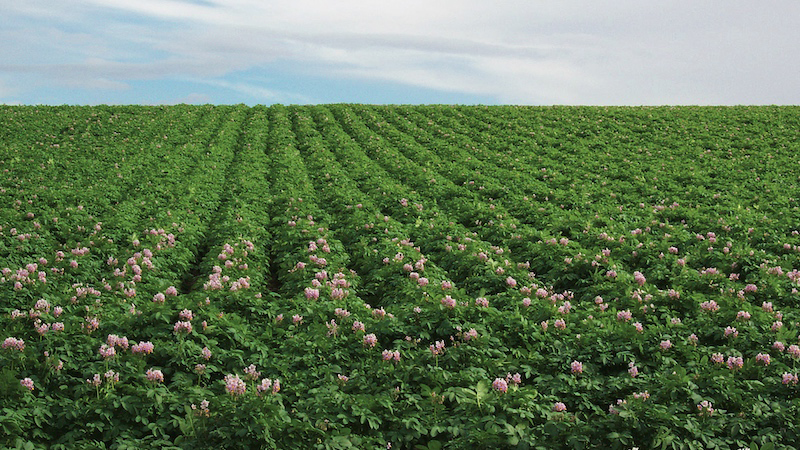Seeking Better Pollination

Last October, USDA awarded Michigan State University (MSU) $1.6 million to lead a national crop pollination research and Extension project. The five-year project, part of USDA’s $101 million Specialty Crop Research Initiative, will focus on supporting specialty crop yields and profit by supporting wild and managed bees.
Rufus Isaacs, MSU entomology professor, and his team will look at specialty crop pollination and develop region- and crop-specific Integrated Crop Pollination management approaches to diversify pollination sources and maintain consistent crop yields. These may include honey bees, wild bees, and alternative managed bees such as bumble bees.
“About four years ago, a group of us started thinking about how we could collaborate across the country on pollination, including different crops and different growers,” says Isaacs. When they learned that pollination research was one of the priorities established by those in determining SCRI funding, they made the decision to apply for a grant.
Several Goals
Along with the researchers who are part of the project, partners also include growers, commodity leaders, commercial suppliers, and more.
“Short term, we are aiming to understand how much contribution native bees and honey bees provide to pollination of specialty crops,” says Isaacs. “We will be identifying farm practices that support those pollinators, and we will look at tactics growers can use, such as habitats, to bring in alternative pollinators.”
One major short-term goal is to give growers realistic, cost-effective pollination options. This will likely include practical information and suggestions that growers can use to get the most out of their pollinators.
In the long term, collaborators (including economists and social scientists) will look at the results of their research and determine ways to best deliver that information to the growers who will ultimately benefit from it. “The ultimate goal of the grant is to improve the sustainability of specialty crops in terms of pollination,” says Isaacs. “We hope to see that in the measurements we are taking.
Addressing Crop Needs
In turning to the grower community for support, the researchers involved in the project targeted those who have expressed an interest, and a need, in pollination.
• In almonds, they will be looking at solitary blue orchard bees, as well as flowering habitats and how they might be used to make bees more productive by having plants bloom at the right time.
• In cherries, they are looking at other species of solitary bees in addition to habitat plantings adjacent to cherry orchards. They are hoping to determine which plant species can best serve as a close habitat resource.
• In blueberries, Isaacs’s team already has data from past research that indicates yield increases when a neighboring bee habitat has been in the ground for a few years. As blueberry production expands nationwide, this data will likely become important in other areas of the country.
The researchers behind this project, including advisory committee members, will be meeting in Florida in January to establish more short- and long-term priorities. In the meantime, Isaacs credits the Specialty Crop Research Initiative as being an essential program that helps incorporate multidisciplinary projects with grower-identified priorities. “It allows researchers to come together in ways we have not done in the past,” says Isaacs. This, of course, means that passing the 2012 Farm Bill is critical. Short-term funding is in place, but future dollars will be based on Farm Bill approval. “Increasingly, people are consuming more fruits, vegetables, and nuts, and these all depend on pollination. As demand increases, it will be essential that growers have the tools needed to ensure they can continue to supply this demand.”
Other SCRI-Funded Projects
Aside from the project covered in this article, a number of other grants funded by the Specialty Crop Research Initiative address important needs for fruit growers:
• The Citrus Research and Development Foundation in Lake Alfred, FL, has a project that will work to eliminate citrus greening by blocking the ability of insects to move the disease from infected trees to healthy ones. The research team will also conduct outreach to growers and consumers to increase the adoption of this new biological control system, which could ultimately be transferred to the citrus industries in Arizona, California, and Texas.
• Purdue University received a grant to develop innovative technologies for automating the dormant pruning of grapes and apples by utilizing modern sensors, computers, and robotic manipulators.
• A Pennsylvania State University project will produce several biopesticides for commercial use to offset the loss of registered chemicals and resistance.
• The USDA-Agricultural Research Service (ARS) laboratory in Davis, CA, will use a grant to develop effective wood-canker disease management strategies that improve the productivity and longevity of almond, grape, and pistachio.
• Another USDA-ARS project will use conventional and novel breeding strategies to develop walnut rootstocks with improved resistance to four major soilborne diseases.










